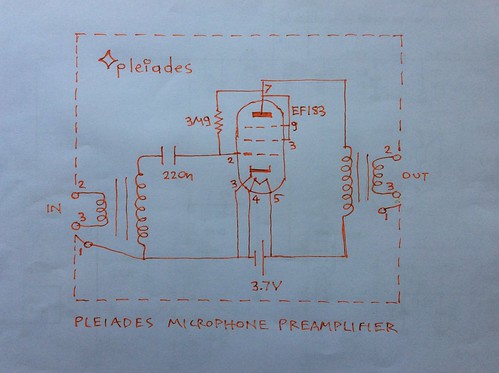It sounds very nice.
The schematic used is the Pleiades V6.

Attention: always use a fuse with any voltage supply source for safety.
The 3.7V battery was replaced with one AA 1.2V battery.
The 1H4 was supported on a Finder relay octal base. The long thin securely screwed leads from the octal base were inserted in the breadboard Pleiades V6 circuit.
Possibly due to no or very low anode current there was almost no sound at all. And in fact the sound must have been just the high Megohm resistor connecting the 2 tansformers. (The Pleiades V6 gives a very faint output even when no power supply is connected).
Signal path, setup:
Male singing voice - mic, Shure SM58 or Sennheiser MD211, Pleiades V6 with Altec 4722 input transformer, Cc is 22nF, 1H4 - Sony TC-D5 Pro - Sennheiser HD580
It was decided to connect a 1.6MΩ (wrong it was a 560Ω) or so pull up resistor. The sound become very bass heavy. (Later addition, due to the mistake in resitor colors the experiment has to be repeated with proper pull up bias resistors and 1.3V plate potential). Repeated experiment with pull up resistor values from 700KΩ to 1.2MΩ. Not impressive results. Sound still buried in hiss. No anode current.
As there was no usable sound it was decided to connect a 9V (10V in fact) battery for plate supply only.
Immediately the anode current jumped to more than 100μA. The sound was loud and even a ticking clock could be heard from a far away room, both naturally by ears and through the headphones.
The sound was bass heavy. So the SM58 Mexico was used at 12in.
Next the MD211 was connected. The sound was a bit bass heavy.
Then the pull up 1.3V rail was disconnected. So effectively the 6MΩ or 2.7MΩ pull up resistor from anode to grid was disconnected. The grid was left floating at its free, space potential, negative potential with respect to cathode.
The sound was big and brilliant. It sounded a bit like double tracking.
At free grid conditions the anode current dropped to 10μA. So the bass heaviness disappeared too due to a higher internal electron tube plate resistance driving the inductance of the output transformer. (Loaded by the inductance of the primary).
Very nice sound. Reminds the big sound of a world class condenser electron tube mic. It is amazing how revealing electron tubes designed so many decades ago can be.
Disconecting the mic an interesting mid range hiss could only be heard.
Connecting a short circuit XLR at the input the hiss becomes from mid range to broadband. A 200Ω wirewound XLR male plug was then connected producing more such hiss.
When the mic is connected there is a big ambience sound.
And a pristine vocal sound captured by the world class Sennheiser MD211 N.
There may be a lot of RF to the electron tube as all its connecting leads were at least 12in long.
The 1H4 glass was producing a nice microphonic sound when gently taped. Great attention must be to the slightest movement of leads especially of the heaters, as the breadboard connections are not of too quality. It may sound like thunder. So whenever the slightest even physical adjustment had to be made the limiter switch was activated on the Sony as well as the input attenuation pad.
The only connection to the control grid is the secondary of the input transformer trough the 22nF DC isolating or blocking capacitor. So the grid is at space potential.
Free grid (some hundred millivolts negative due to electron emission velocity) can sound free.
(What can be also tried is another AA battery instead of the 9V battery (through fuse or in series with fuse for safety) so that plate supply can be 2.6V. Then pull up bias can be used for an anode current of 10μA and comparing the sound quality).
Also how about a 9V battery (in series with a fuse for safety) supplying both heater and plate of a 12SK7, UF89, or ECC82 12AU7, Nuvistor 13CW4 with grid at space potential? Thoughts continued on another today's post.
See also that the grid space potential increases when 9V is applied to the plate of the 1H4.
http://euroelectron.blogspot.com/2018/08/the-grid-space-potential-increases-when.html
No comments:
Post a Comment